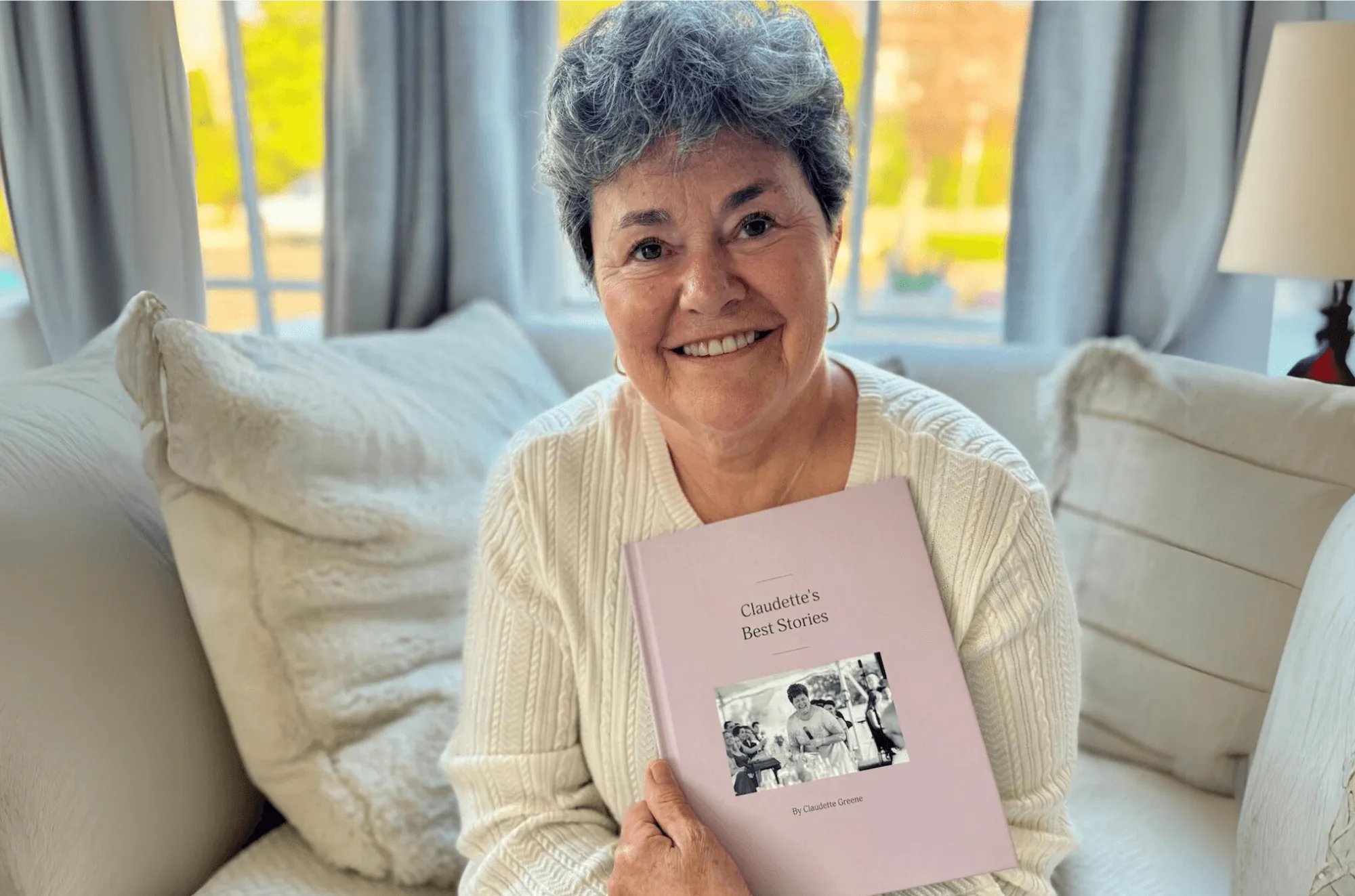Guaranteed to teach you things you never knew.
How Mell Uses Remento to Record and Preserve Family Stories by Voice
Audio genealogist Mell shares how Remento helps him capture authentic, emotional life stories through voice, with no writing required.
Mell Turford is an audio genealogist with a deep passion for storytelling. He believes that behind every name, every date, and every photograph, there’s a human story waiting to be remembered. His work centers on helping others share those stories, and Remento has become one of his favorite ways to do just that.
How genealogists capture family stories without writing
The challenge of preserving family stories often begins with a fundamental barrier: the intimidation of writing. While most families recognize the importance of documenting their history, the prospect of crafting polished narratives can prevent meaningful stories from ever being captured. This hesitation has led professional genealogists and family historians to embrace speech-first recording methods that prioritize authentic storytelling over perfect prose.
Audio genealogist Mell has spent years helping families navigate this challenge. Through his extensive work in family story preservation, he has discovered that the most compelling family histories emerge not from carefully written manuscripts, but from spontaneous, emotional reflections captured through spoken storytelling. His approach demonstrates how modern platforms like Remento can transform the family memory preservation process by eliminating writing requirements while maintaining the emotional nuance that makes stories truly memorable.
"With Remento, it's more than storytelling," Mell explains. "It's capturing the essence of who someone is, in their own words." This perspective reflects a growing understanding among genealogy professionals that recorded reflections offer something written transcripts cannot: the preservation of personality, emotion, and authentic human connection across generations.
Why Speech-First Storytelling Transforms Family Memory Preservation
Traditional approaches to family history often require extensive writing, editing, and organizational skills that can overwhelm busy families or intimidate older relatives. Mell's professional experience reveals a fundamental truth: when people can simply speak their stories, they share more openly and authentically than when facing the pressure of writing.
According to the American Psychological Association, oral storytelling activates different cognitive processes than written communication, often leading to more emotional and detailed recollections. This research supports what Mell observes in his client work: families discover stories they never knew existed when the writing barrier disappears.
"Remento makes the whole process feel more natural," Mell notes. "People speak freely and share more deeply when they're not worried about grammar or sentence structure." This observation aligns with his experience across hundreds of family projects, where spoken reflections consistently reveal details and emotions that remain hidden in traditional written approaches.
The platform's guided approach particularly benefits families where storytellers may feel uncertain about where to begin. Rather than facing a blank page, users respond to thoughtful prompts designed to unlock specific memories and experiences. These expert-curated questions often surface stories that might never emerge in casual family conversations.
How Professional Genealogists Use Recording Technology for Client Projects
Mell's methodology demonstrates practical applications that families can adapt for their own storytelling projects. His systematic approach has evolved through years of helping families capture and preserve their most meaningful memories.
Prompt-Based Memory Discovery
The foundation of Mell's process involves using carefully crafted questions to guide conversations toward significant memories. Remento's expert-curated prompts serve as starting points, but Mell often customizes questions based on each family's unique history and circumstances.
Photo-Triggered Storytelling Sessions
One of Mell's most effective techniques involves pairing family photographs with targeted questions. By uploading meaningful images to Remento, he creates specific prompts that help storytellers recall particular moments, relationships, or family events.
This approach proves especially valuable for accessing childhood memories or explaining complex family relationships. "A single photograph can transport someone back 60 years," Mell observes. "Suddenly they're describing not just what happened, but how they felt, what they were thinking, and details they haven't remembered in decades."
Building Comprehensive Family Narratives
Rather than attempting to capture entire life histories in single sessions, Mell advocates for an iterative approach. Multiple recording sessions allow stories to build upon each other, with new details emerging as storytellers become more comfortable with the process.
"The best family stories unfold over time," he notes. "Someone might mention their grandmother in passing during one session, then spend an entire recording the following week sharing memories about her garden or her cooking." This patient approach yields more comprehensive and emotionally rich family narratives.
The Technology Behind Emotional Memory Preservation
What distinguishes Remento in professional genealogy work is its comprehensive approach to family story documentation. Unlike simple recording apps or traditional interview methods, the platform creates a complete storytelling ecosystem that serves both immediate family connection and long-term legacy preservation.
Mell particularly values Remento's Speech-to-Story technology, which addresses a common challenge in his work: making recorded stories accessible and readable while maintaining their original emotional impact. "Families want both experiences," he explains. "They want to read the stories like a traditional family history, but they also want to hear their loved one actually telling those stories."
The platform's dual-format approach provides exactly this combination. The resulting hardcover books contain polished, readable narratives alongside QR codes that instantly play the original recordings when scanned. This design ensures that future generations can both read their ancestor's words and experience their actual presence through their recorded reflections.
For families working with professional genealogists like Mell, this technology eliminates common friction points. Storytellers don't need to download apps, create passwords, or learn complex systems. They simply click a link and begin sharing their memories, much like leaving a message for family members.
Choosing the Right Platform for Family Story Projects
While Remento serves Mell's professional needs effectively, he acknowledges that different families may prioritize different features based on their specific circumstances and preferences.
Traditional text-based platforms work well for families where the storyteller enjoys writing and has strong composition skills. These services can produce polished written narratives without requiring speech-to-text technology, making them suitable for families comfortable with traditional memoir approaches.
However, for families dealing with physical limitations, technology hesitation, or simple preference for spoken communication, speech-first platforms offer distinct advantages. "For them, Remento removes barriers that would otherwise prevent their stories from being preserved at all."
The platform's newer presence in the market means fewer online reviews compared to established alternatives, though Mell's professional experience and early customer feedback consistently demonstrate strong satisfaction with both the storytelling process and final products.
Key factors families should consider when choosing memory preservation platforms include the storyteller's comfort with technology, physical limitations that might affect writing, and whether preserving the actual speaking experience matters for future generations.
Professional Best Practices for Family Story Recording
Based on his extensive client work, Mell has developed specific techniques that maximize recording platform effectiveness, regardless of which service families choose:
Pre-Recording Preparation
Before beginning any recording sessions, Mell helps families identify key life periods, significant relationships, and meaningful objects or photographs that can serve as storytelling triggers. This preparation phase often reveals themes and connections that guide the overall project direction.
Creating Optimal Recording Environments
Simple environmental considerations can dramatically improve both recording quality and storyteller comfort. Mell recommends quiet spaces free from distractions, comfortable seating that encourages relaxed conversation, and good lighting when recording includes video elements.
Encouraging Family Collaboration
One of Mell's most effective strategies involves encouraging multiple family members to participate in the prompt creation process. When children, grandchildren, or siblings suggest questions, storytellers often feel more motivated to participate and share more comprehensive accounts.
Maintaining Momentum Through Regular Sessions
Rather than sporadic, lengthy recording sessions, Mell advocates for consistent, shorter sessions that build family narratives over time. This approach prevents fatigue while allowing stories to develop naturally as memories surface.
The Impact of Memory Preservation on Family Connections
Beyond creating historical documents, Mell has observed that the recording process itself strengthens family relationships in unexpected ways. Families frequently report that listening to early recordings sparks new conversations and reveals shared experiences they hadn't previously discussed.
This ongoing connection represents one of the most significant differences between speech-based and text-based family history projects. When family members receive new recordings regularly, they experience an ongoing relationship with the storytelling process rather than simply waiting for a completed book.
Getting Started with Professional-Grade Family Storytelling
For families inspired by Mell's approach to speech-first family history, several key principles can guide successful memory preservation projects:
Start with clear intentions about what stories matter most to your family. While comprehensive life histories have value, focused projects around specific themes, military service, immigration experiences, or childhood memories, often yield more detailed and emotionally resonant results.
Consider the storyteller's preferences and limitations when choosing platforms and approaches. Some family members thrive with open-ended questions, while others need specific prompts or photo triggers to feel comfortable sharing memories.
Plan for the long term by thinking about how these stories will be accessed and shared across generations. Platforms that provide both written transcripts and playable recordings offer maximum flexibility for future family members with different preferences.
Finally, recognize that the storytelling process itself creates value beyond the final product. Regular recording sessions become opportunities for family connection and discovery that often prove as meaningful as the preserved stories themselves.
Whether you're preserving an elderly relative's memories before it's too late, or creating ongoing family storytelling traditions that span multiple generations, the speech-first approach demonstrates consistent advantages over traditional writing-based methods.
To explore how Remento works and see examples of the beautifully crafted books that result from this process, visit our How it Works page. For families ready to begin their storytelling journey, our customer testimonials section provides additional examples of successful family projects and their meaningful outcomes.

Their stories, forever at your fingertips
Remento’s life story books turn a parent or grandparent’s memories of the past into a keepsake book for the future - no writing required.
Capture priceless family memories today
Join the thousands of families using Remento to preserve family history, all without writing a word.
.avif)
